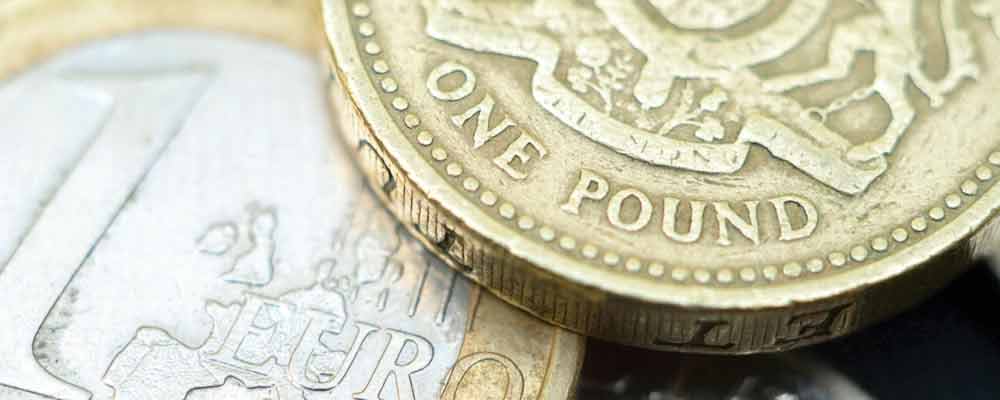- Pound weakened by manufacturing PMI – Post-Brexit measure revised lower
- Bank stress test results boost Euro – Only bank to fail already securing rescue funding
- US Dollar largely resists ISM weakness – Manufacturing growth slows more-than-expected
- GBP EUR, GBP USD Forecast – Pound exchange rates could weaken on Services PMI
BoE Cuts Interest Rate to 0.25% – GBP EUR, GBP USD Exchange Rates Fall
Bets that the Bank of England (BoE) would cut interest rates at its August policy meeting proved justified today as the central bank cut the benchmark rate by 0.25%.
The outcome may have been priced into the market to a certain extent but the Pound still fell against both the Euro and US Dollar after the news was announced, with GBP EUR and GBP USD sliding 1%.
(Previously updated 11:00 GMT)
GBP EUR, GBP USD Exchange Rate Volatility Forecast with Services Data and BoE Rate Decision Ahead
Although the UK’s Construction PMI printed at a seven-year low on Tuesday, the result was ever-so-slightly better than forecast and GBP EUR, GBP USD exchange rates subsequently staged a modest recovery.
However, the Pound dipped on Wednesday ahead of the release of the UK’s Services PMI, with the Pound Euro currency pair trending in the region of 1.1880 and the Pound US Dollar exchange rate lingering around 1.3320.
The currency went on to stage a rebound, and push above 1.19 against the Euro, as the services gauge came in as economists anticipated. This was despite the composite estimate being revised down -0.2 points to 47.5, weakening the outlook for the UK economy going forwards.
Concerns that the BoE may fail to unveil substantial stimulus measures tomorrow were also responsible for the Pound’s gains. There is still an argument to be made for the BoE waiting until September to collect more post-Brexit data before altering monetary stimulus. However, according to Markit’s Chris Williamson, the latest PMI scores have made an interest rate cut from the Bank of England seem ‘a foregone conclusion’. Whether or not the Bank will also unleash quantitative easing measures still remains to be seen.
While the Pound remains well down on its pre-Brexit levels, the currency has actually proven itself to be surprisingly resilient in the face of all the uncertainty. Some economists had anticipated a leave vote driving Sterling down by as much as 20%. While GBP’s actual losses weren’t quite this steep, expansive easing from the BoE could send Sterling spiralling.
(Previously updated 02/08/2016)
UK manufacturing contracted at a faster pace than initially believed in July, causing a widespread Pound selloff which weakened GBP EUR and GBP USD.
Worse-than-Expected UK Manufacturing Data Undermines Pound Strength
A revised manufacturing PMI for July showed that the sector had experienced a more extreme reaction to the UK’s vote for Brexit than first imagined. The flash version of the PMI, released last month, had shown that manufacturing entered contraction following the Brexit vote with a score of 49.1. The figure had been a silver lining to the post-Brexit cloud, however, as the services and composite PMIs had registered more severe declines than initially forecast. The updated version of the survey shows a similar dovishness from the manufacturing sector as seen in other areas of the economy, with an unexpected printing of 48.2 dashing tentative hopes of a small upward revision.
Senior Markit Economist Rob Dobson commented that;
‘The pace of contraction was the fastest since early-2013 amid increasingly widespread reports that business activity has been adversely affected by the EU referendum. The drops in output, new orders and employment were all steeper than flash estimates…’
Euro Responds Better than Stocks to Eurozone Bank Stress Test Results
Markets were yesterday digesting the results of the latest Eurozone bank stress tests, which were published on Friday after the European trading session had closed. The test results, which markets had feared would be dire, showed that the majority of Eurozone banks were suitably capitalised to withstand another severe financial downturn.
The Euro advanced following these signs of strength in the Eurozone banking sector, although investors were less impressed with the results. Stocks in European banks saw a strong decline, but the common currency advanced, with traders in the Euro seemingly happy at what Citigroup analyst Christian Schulz described as ‘a gradual improvement’ rather than a turning point, commenting;
‘The 2016 stress test is unlikely to fully restore investors’ trust in the Eurozone banking system, in our view.’
Helping to keep investors positive was the fact that the only bank to fail the stress tests, Italy’s oldest lender Monte dei Paschi, had announced a €5 billion rescue deal with the private sector to help it combat its mountainous €50 billion worth of bad debts.
ISM Manufacturing Disappoints; US Dollar Softens but Remains Strong

Weak Chinese manufacturing data helped to boost the US Dollar on falling demand for high-yield assets such as the Australian Dollar (AUD) yesterday, despite the approach of negatively forecast data. The ISM Manufacturing index disappointed forecasts, falling from 53.2 to 52.6 instead of the marginal -0.2 point decline predicted.
Maria Fiorini Ramirez Inc. Chief US Economist Josh Shapiro commented;
‘Over the near term, I think it’s just going to be plodding along, slow growth. It’s not like we’ve been getting wonderful economic news from around the world.’
Chairman of the ISM factory survey Bradley Holcomb believes that the outlook for US manufacturing is still positive, despite the greater-than-expected decline, noting;
‘We’re pretty much where we were last month, and we’re on a pretty positive trend over the last five to seven months.’
The result has weakened Federal Reserve rate hike bets once again, which had enjoyed a small recovery since Friday’s dovish GDP results. Ahead of the ISM release, Fed Funds futures had just about priced in monetary tightening by July 2017, but bets returned to favouring the current interest rates remaining on hold for at least the next twelve months.
GBP EUR, GBP USD Exchange Rate Forecast; Construction PMI Likely to Weaken Pound
There are several reasons for markets to assume that today’s UK construction sector PMI for July will print poorly. Firstly, all the other UK PMIs since the Brexit vote have revealed strong contractions in response. Secondly, the contractions were worse-than-expected in all cases, with yesterday’s manufacturing PMI revision proving that no sector has escaped unscathed. Finally, the sector was already strongly in contraction territory before the referendum even took place, as building projects were put on hold ahead of the decisive vote. The current reading of 46 is expected to weaken to 44, although there is potential for this to fall even lower.
GBP, EUR, USD Conversion Rates
The Pound Euro (GBP EUR) exchange rate was trading in the region of 1.1819, while the Pound US Dollar (GBP USD) exchange rate trended in the region of 1.3208 during yesterday’s European session.



